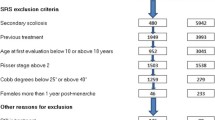Abstract
Trials often do not succeed in including as many patients as anticipated beforehand. The aim of this paper was to describe why we were not able to include more than a few patients in our randomized controlled treatment trial on the effectiveness of bracing patients with idiopathic scoliosis, and to describe which lessons can be learnt. A pilot study on the willingness to participate in such a trial was conducted amongst 21 patients and their parents. A description of how we prepared and designed this trial, the problems we faced and how we tried to improve the inclusion are given. A total of four patients were included, and 14 refused to participate in an 18-month period. There were a lot less eligible patients than anticipated (40 instead of 100 per year), and the patients’ participation rate was much lower than we had found in our pilot study (21% instead of 70%). The trial failed to include more than a few patients because of an overestimation of the number of eligible patients and because a lot less eligible patients were willing to participate compared to our pilot study. One reason for a low participation rate could be that this trial evaluated a frequently used existing treatment instead of a new treatment, and patients and parents might be afraid of not being treated (despite an intensive secure system for the control arm).


Similar content being viewed by others
References
Benard M, Juttmann RE (2001) Feasibility of an RCT on bracing patients with adolescent idiopathic scoliosis. Department of Public Health, Erasmus MC, Rotterdam
Bunge EM, de Koning HJ, the brace trial group (2008) Bracing patients with idiopathic scoliosis: design of the Dutch randomized controlled treatment trial. BMC Musculoskelet Disord 9:57
Bunge EM, Juttmann RE, de Koning HJ, the steering committee of the NESCIO group (2006) Screening for scoliosis: do we have indications for effectiveness? J Med Screen 13:29–33
Bunge EM, Juttmann RE, van Biezen FC, Creemers H, Hazebroek-Kampschreur AA, Luttmer BC et al (2008) Estimating the effectiveness of screening for scoliosis: a case-control study. Pediatrics 121:9–14
Bunnell WP (1993) Outcome of spinal screening. Spine 18:1572–1580
Bunnell WP (2005) Selective screening for scoliosis. Clin Orthop Relat Res (434):40–45
Campbell W, Canale S, Daugherty K, Crenshaw A Jr (2003) Scoliosis and kyphosis. In: Campbell’s operative orthopaedics. Mosby, St. Louis, pp 1751–1984
Donnelly MJ, Dolan LA, Weinstein SL (2003) How effective is bracing for treatment of scoliosis? Am Fam Physician 67:32
Goldberg CJ, Dowling FE, Hall JE, Emans JB (1993) A statistical comparison between natural history of idiopathic scoliosis and brace treatment in skeletally immature adolescent girls. Spine 18:902–908
Grol R, Grimshaw J (2003) From best evidence to best practice: effective implementation of change in patients’ care. Lancet 362:1225–1230
Haidich AB, Ioannidis JP (2001) Patterns of patient enrollment in randomized controlled trials. J Clin Epidemiol 54:877–883
Harris E, Fitzgerald J (1970) The principles and practices of clinical trials. E&E Livingstone, Edinburgh
http://clinicaltrials.gov, NCT00448448
Korfage IJ, Juttmann RE, Das BV, Diepstraten AF, Hazebroek-Kampschreur AA, Maas van der PJ (2002) [Idiopathic scoliosis in adolescents; an inventory into the possibilities of studying the efficacy of screening and treatment] Idiopathische scoliose bij adolescenten; inventarisatie van mogelijkheden van onderzoek naar de effectiviteit van screening en behandeling. Ned Tijdschr Geneeskd 146:1228–1233
Lenssinck ML, Frijlink AC, Berger MY, Bierman-Zeinstra SM, Verkerk K, Verhagen AP (2005) Effect of bracing and other conservative interventions in the treatment of idiopathic scoliosis in adolescents: a systematic review of clinical trials. Phys Ther 85:1329–1339
Lumley J, Lester A, Renou P, Wood C (1985) A failed RCT to determine the best method of delivery for very low birth weight infants. Control Clin Trials 6:120–127
McDonald AM, Knight RC, Campbell MK, Entwistle VA, Grant AM, Cook JA et al (2006) What influences recruitment to randomised controlled trials? A review of trials funded by two UK funding agencies. Trials 7:9
Nachemson AL, Peterson LE (1995) Effectiveness of treatment with a brace in girls who have adolescent idiopathic scoliosis. A prospective, controlled study based on data from the Brace Study of the Scoliosis Research Society. J Bone Joint Surg Am 77:815–822
Paine BJ, Stocks NP, Maclennan AH (2008) Seminars may increase recruitment to randomised controlled trials: lessons learned from WISDOM. Trials 9:5
Ruddell M, Spencer A, Hill K, House A (2007) Fluoxetine vs placebo for depressive symptoms after stroke: failed randomised controlled trial. Int J Geriatr Psychiatry 22:963–965
Ryan R, Prictor M, McLaughlin K, Hill S (2008) Audio-visual presentation of information for informed consent for participation in clinical trials. Cochrane Database Syst Rev (1), Art. No. CD003717. doi:10.1002/14651858.CD003717.pub2
Styblo K (1991) Conservative treatment of juvenile and adolescent idiopathic scoliosis: a clinical, roentgenological and comparative retrospective study on the effects of conservative treatment by brace in 290 juvenile and adolescent consecutive patients. 1991. p 167
van der Wouden JC, Blankenstein AH, Huibers MJ, van der Windt DA, Stalman WA, Verhagen AP (2007) Survey among 78 studies showed that Lasagna’s law holds in Dutch primary care research. J Clin Epidemiol 60:819–824
Weinstein SL, Dolan LA, Cheng JC, Danielsson A, Morcuende JA (2008) Adolescent idiopathic scoliosis. Lancet 371:1527–1537
Wollersheim H, Burgers J, Grol R (2005) Clinical guidelines to improve patient care. Neth J Med 63:188–192
Acknowledgments
This study was funded by the Netherlands Organization for Health Research and Development (ZonMw) Grant # 945-06-354, Stichting Nuts Ohra Grant # SNO-T-06-27 and Vereniging Trustfonds Erasmus Universiteit Rotterdam.
Author information
Authors and Affiliations
Corresponding author
Rights and permissions
About this article
Cite this article
Bunge, E.M., Habbema, J.D.F. & de Koning, H.J. A randomised controlled trial on the effectiveness of bracing patients with idiopathic scoliosis: failure to include patients and lessons to be learnt. Eur Spine J 19, 747–753 (2010). https://doi.org/10.1007/s00586-010-1337-6
Received:
Revised:
Accepted:
Published:
Issue Date:
DOI: https://doi.org/10.1007/s00586-010-1337-6




